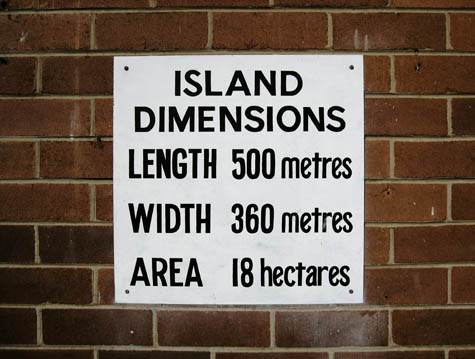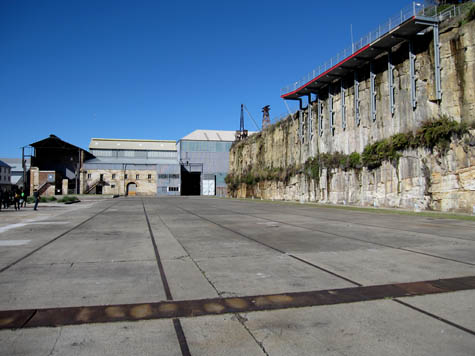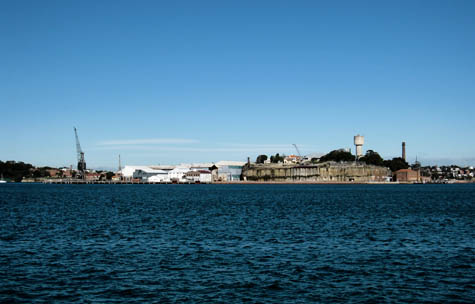Urban Islands continues apace down here in Sydney, with Day Five beginning in about an hour. While I'll describe the actual studio process in some detail later on, it seems worth recounting our trip out to Cockatoo Island – a derelict shipbuilding site and former prison in the Sydney Harbor – earlier this week.  [Image: The dimensions of an island: a sign posted on Cockatoo].
[Image: The dimensions of an island: a sign posted on Cockatoo].
We went out as a massive group of about 70 people and spent a bit more than five hours there, wandering around through old turbine halls and tunnels, walking past fenced-off but still functioning lift shafts cut directly through an eroded plateau of sandstone, and exploring former convict barracks, exercise yards, a Submarine Weapons Workshop, and the lost interiors of buildings demolished long ago, their internal walls, spaces, and bays still marked by iron rails set rhythmically in the concrete.
The first step was for our students to install small models that they'd built the night before, fitting them into cubbyholes inside an old warehouse near the turbine hall.
The cubbyholes themselves were all very strangely labeled, however, referring to old tools and other handheld pieces of industrial equipment; but the words written on them in black lettering were more like a set-list by the Aphex Twin than a serious description of useful implements: Vodex Elect, Murex Vodex, Yorkshire Flux.
After that first exercise was over – and there were some fantastic projects on display, from a conic room-amplification device to mirrored boxes and temperature-sensitive geometries – we broke up into our respective tutorial groups, approximately 16 students per group, and headed outside to sit amidst that old iron grid in the concrete, looking out through a missing interior that still seemed to haunt the island's perimeter.  [Image: The gridded rails of a lost interior, Cockatoo Island, in Sydney Harbor].
[Image: The gridded rails of a lost interior, Cockatoo Island, in Sydney Harbor].
I'll explain in another post what it is that I'm having my students do – though I will say that it involves what I hope is an exciting mix of formal landscape analysis, combinatorial mythology, and Tarot cards (yes, Tarot cards) – but this first day out on the site was more of an introduction to the spectacular historical landscapes on display there in the harbor.
From recently discovered "convict structures" under active excavation at the top of a hill to the long stories of ships constructed on Cockatoo – warships drifting outward in an endless archipelago of micro-islands – by way of the extraordinary Mould Loft, where massive ribs and geometries for future ships were outlined with chalk drawings on the floor, cut into wood, sent down piece by piece to be remade in metal, and then assembled again, like dinosaur skeletons, into boats and submarines, Cockatoo is a three-dimensional catalog of unique situations and spaces.
When does a ship cease to be a part of the island that created it? Perhaps ships are to Cockatoo as pollen is to flowers.
There is electrical equipment still sitting there like something from The Prestige, converting DC current from mainland Australia to the island's AC needs; there is a locked switchboard room inside of which phonecalls used to be connected through grids of wires; and there are entire missing hillsides – artificial cliffs still marked with drilled incisions for dynamite – that you then realize aren't missing at all, they've simply been transformed into the ground you're standing on, the island having been expanded in size nearly fourfold through a coastal growth that pushed the island's perimeter further and further out to the sea, like terrestrial rings for a maritime Saturn.
There are moving walls formerly used to plug-up the dry docks; there is ship-launching equipment; there was the deliberate feeding of harbor sharks to turn them into a living security fence against the island's 19th-century prisoners; and there is the incredible angular cross-bedding of ancient sand dunes now frozen into permanent form as the island's central plateau.
There is a filled well; a campground for tourists; inflatable "slave docks" that could temporarily expand the outer edge of the island; and all around us were things that had yet to be constructed, from viewing platforms planned by the Harbour Trust to our own students' future installations.  [Image: Cockatoo Island in profile].
[Image: Cockatoo Island in profile].
While I suppose all islands lend themselves well to mythology, Cockatoo seems particularly well-suited to a kind of over-the-top symbolic analysis – the bizarrely preserved film set from Wolverine, the space of the Turbine Hall so immeasurably huge that they had to install visual guide tags for laser-based surveying equipment, the escaped ship that beached itself on a neighboring island – that it seems impossible to believe architects working there could not foreground the narrative potential of the site. Even if only as a way to recombine and situationally understand the possibilities of an island, delving into the mythology of Cockatoo seems both incredibly fun and architecturally necessary.
It's an history full of plane crashes and visiting aviators, with a backwards warship that arrived without a bow to be temporarily repaired by workers on inflatable slave docks, and there are the hollow voids of old grain silos visible in section on the sides of collapsed hills, connected onward to an internal network of rock-cut drains and reservoirs...
Obviously, I hope my own studio here – breaking down Cockatoo into its major and minor spatial types and material details for the purpose of performing an oblique combinatorial analysis – will draw on these histories and forms, but we'll have to see if two weeks is enough time even to begin exploring such extraordinary symbolic potential.
(For a bit more about Urban Islands, check out Design + Build and these two posts by Nick Sowers of Soundscrapers fame).
Lưu trữ Blog
-
▼
2009
(1255)
-
▼
tháng 7
(79)
- What makes you happy?
- We won't have much to hunt in the Autumn
- Army
- The Bat Spiral
- TON
- Are you Rapture Ready?
- Magic Number Spurs Debate
- Bells and whistles
- Architecture of the Blink
- Pikes Peak Scouting Run
- Victory for Ottawa Gardeners
- It’s good to be back
- Please
- Week Ending July 26
- Netflix Prize Competition Closes - But No Winner A...
- Week 5-Jog Blog. Needles and stitches.
- Playlist - 25th July 2009
- Respect for Canada's Boreal
- Dad
- A Pikes Surprise
- I have tough teeth
- Looking for an Awesome Deal on a Pair of Sportiva ...
- Jade says I look like Bruce Willis
- 7 sins - vanity
- Rwanda Beekeeper Sparked Fire, Endangered Gorillas
- Eureka in Manila
- The end in friendship
- In the Land of Dragons
- Fenny @ Beatherder
- Week Ending July 19
- Kakapo Say Farewell to City Adventure
- Weeks 3 and 4: Jog Blog
- Loveland Classic 10k
- Playlist - 18th July 2009
- David Attenborough's Life Stories: Komodo Dragon
- New Zealand Bird Call Man Honoured by Forest and Bird
- A Beautiful Effect of Climate Change?
- The Sage Grouse Victory Dance
- Celebrating....and many, many other important things.
- Wanderlust Interview with Stephen Fry and Mark Car...
- The Dimensions of an Island
- Bloodpen
- Thirsty Koalas
- Global Warming's Magic Number
- A Flamboyant Win for Endangered Sage Grouse
- Gratitude
- Fighting for Pesticide Free Gardens
- Bark beetle traps
- Leadville Marathon
- Lazy summer day
- Week Ending July 12
- Playlist - 11th July 2009 - Funkology
- Image Issues...
- Google Apps, Mail.app and the iPhone
- Ludicrous Job Title Awards: IV
- Chocolate death
- Gathering place
- Katydid
- Bravo, BRAVIA!
- Leadville Marathon Preview
- Caterpillar identifier page
- Michael Jackson Grand Wailing and Gnashing Sobbathon
- Flying Update
- One Weekend, Two Outrageous Races: The Hard and th...
- In a heartbeat
- Stardust Bunny
- Week Ending July 5
- FireKracker 5k
- Jog Blog: Week 2
- Playlist - 4th July 2009
- Round Mountain Summer Time Trial
- I guess it saves on the washing up
- All work and no play
- handsome gray hairstreak
- cute and cozy bluegreen sharpshooters
- I like drinking Naked
- The Perfect Mountain Running Shoe?
- June Miles/Dollars
- Read all about it!
-
▼
tháng 7
(79)